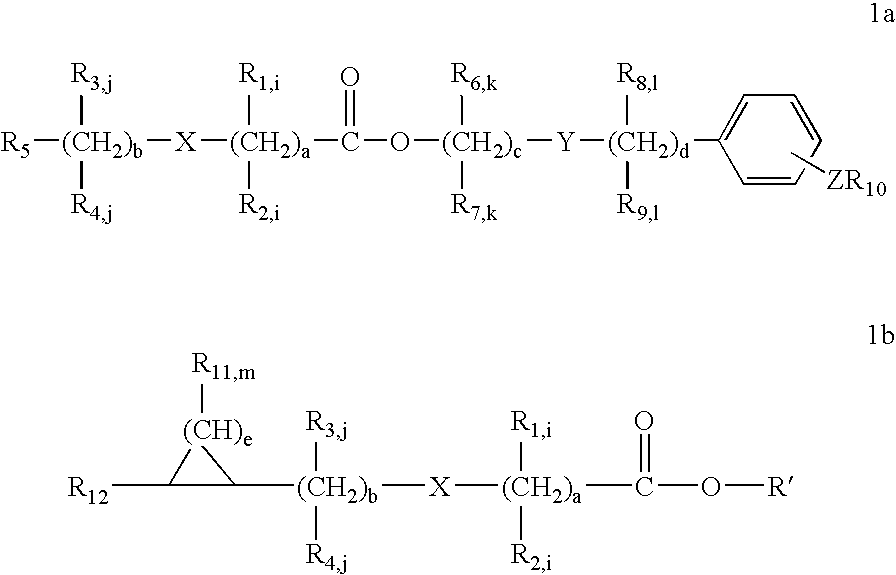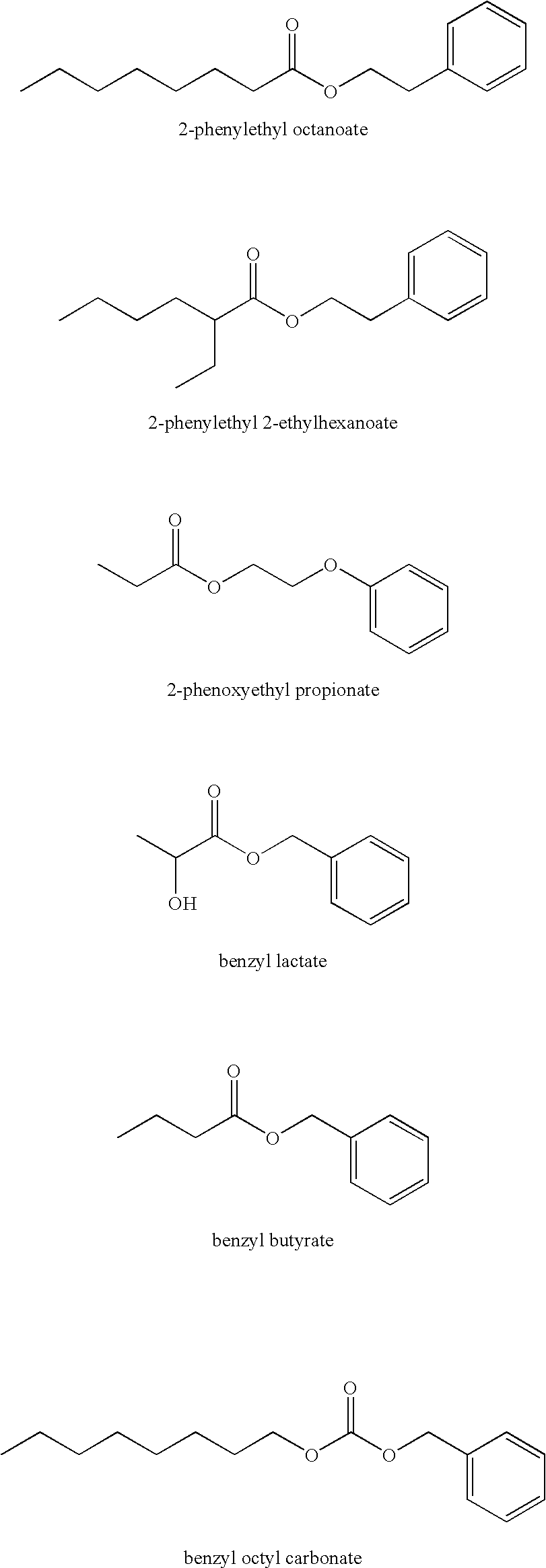Solubilizing agents for active or functional organic compounds
a technology of organic compounds and solvents, applied in the field of compositions containing active or functional organic compounds, can solve problems such as ‘heavy’ feel and cosmetic formulations
- Summary
- Abstract
- Description
- Claims
- Application Information
AI Technical Summary
Benefits of technology
Problems solved by technology
Method used
Image
Examples
example 2
Preparation of 2-Phenylethyl Pentanoate
[0023] A 2-L, 4-neck, round-bottom flask, fitted with a thermometer, mechanical stirrer, nitrogen inlet tube and Liebig condenser / receiving flask, was charged with 612.8 g (6.00 mol, 1.00 equiv) of pentanoic acid, 733.0 g (6.00 mol, 1.00 equiv) of 2-phenylethanol, and 2.50 g (0.2 wt. %) of tin oxalate (Fascat® 2001). The air was removed with three cycles of evacuation / nitrogen-fill using a mechanical vacuum pump (50-100 torr). The rate of stirring was set at ca. 200 rpm, the nitrogen sparge was set at 0.1 scfh, and the reaction mixture was heated to 170° C. After a 1-h hold, 159.3 g of distillate had been collected. It was not possible to get a clean separation; therefore, the organic layer was not returned to the reaction mixture. The temperature was increased to 180, 190, 200 and 210° C. and held for 1 h at each; the amounts of distillate were 21.4, 9.8, 4.9 and 2.2 g, respectively. The acid number was 2.88 mg KOH / g (99.0% conversion). The e...
example 3
Preparation of 2-Phenylethyl Cyclohexanecarboxylate (2-Phenylethyl Cyclohexanoate)
[0024] A 1-L, 4-neck, round-bottom flask, fitted with a thermometer, mechanical stirrer, nitrogen inlet tube and Liebig condenser / receiving flask, was charged with 320.4 g (2.50 mol, 1.00 equiv) of cyclohexanecarboxylic acid, 335.9 g (2.75 mol, 1.10 equiv) of 2-phenylethanol, and 1.20 g (0.2 wt. %) of tin oxalate (Fascat® 2001). The system was heated gently with slow stirring (<50 rpm) until all the cyclohexanecarboxylic acid was in solution. The air was removed with three cycles of evacuation / nitrogen-fill using a mechanical vacuum pump (50-100 torr). The rate of stirring was increased to ca. 200 rpm, the nitrogen sparge was set at 0.1 scfh, and the reaction mixture was heated to 180° C. After a 1-h hold, 36.7 g of distillate had been collected. The alcohol (9.6 g) was separated and returned to the reaction mixture. The temperature was increased to 190° C. and held for 1 h; an additional 14.0 g of di...
example 4
Solubility of Solid Organic Sunscreens in Solubilizers of the Invention
[0025] Solutions (wt. %) of Avobenzone (E-517), Oxybenzone (E-567), 4-Methylbenzylidene camphor (MBC), Ethylhexyl triazone (EHT) or Bis-ethylhexyloxyphenol methoxyphenyl triazine (BEMT) in each of the solubilizers were prepared at 40-60° C. such that the total mass was 10.00 g. Upon cooling to 25° C., a few seed crystals (<10 mg) of the sunscreen were added to hasten equilibration. The solutions were stored in the dark in a constant temperature chamber at 25° C. Each was sampled weekly, and the ca. 0.1 g sample was filtered through a 0.45μ syringe filter and analyzed by GLC or HPLC, calibrated using standard solutions, until the value for wt. % of solute was constant.
[0026] As shown below in Table 1, the solubilizer of the invention is effective in solubilizing at least 10 wt. %, preferably 20 wt. %, most preferably 30 wt. % or more of at least one of the sunscreens. In every case, the solubility of one or more...
PUM
| Property | Measurement | Unit |
|---|---|---|
| temperature | aaaaa | aaaaa |
| temperature | aaaaa | aaaaa |
| temperature | aaaaa | aaaaa |
Abstract
Description
Claims
Application Information
 Login to View More
Login to View More - R&D
- Intellectual Property
- Life Sciences
- Materials
- Tech Scout
- Unparalleled Data Quality
- Higher Quality Content
- 60% Fewer Hallucinations
Browse by: Latest US Patents, China's latest patents, Technical Efficacy Thesaurus, Application Domain, Technology Topic, Popular Technical Reports.
© 2025 PatSnap. All rights reserved.Legal|Privacy policy|Modern Slavery Act Transparency Statement|Sitemap|About US| Contact US: help@patsnap.com



